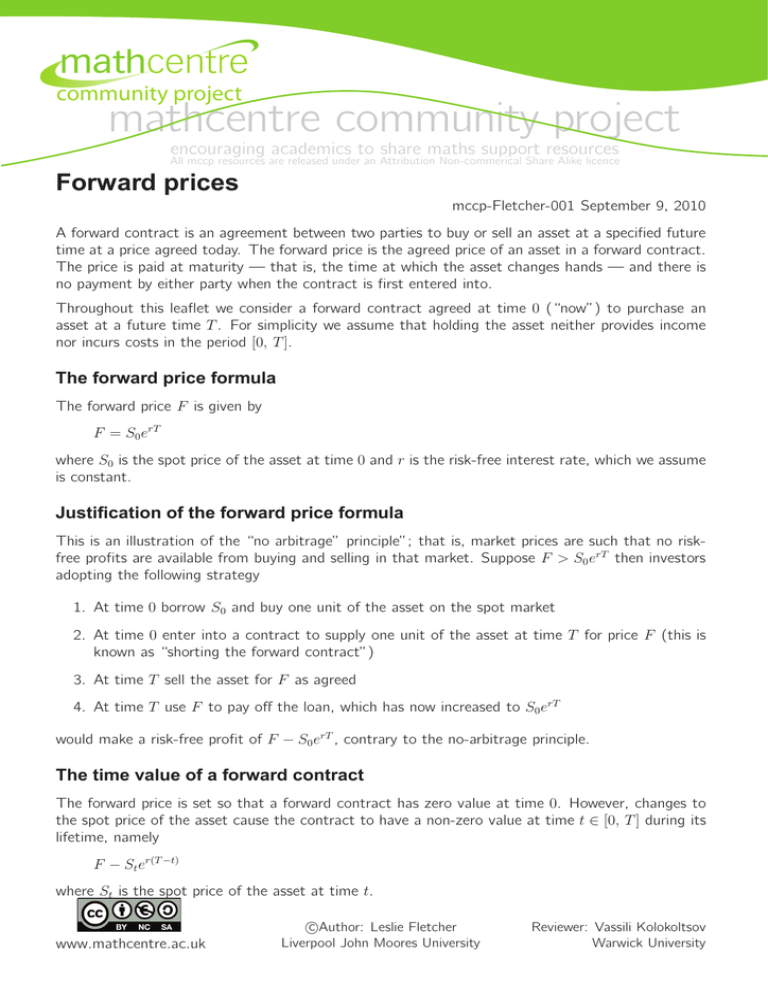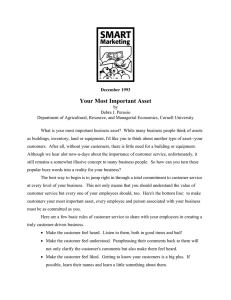mathcentre community project Forward prices community project
advertisement

community project mathcentre community project encouraging academics to share maths support resources All mccp resources are released under an Attribution Non-commerical Share Alike licence Forward prices mccp-Fletcher-001 September 9, 2010 A forward contract is an agreement between two parties to buy or sell an asset at a specified future time at a price agreed today. The forward price is the agreed price of an asset in a forward contract. The price is paid at maturity — that is, the time at which the asset changes hands — and there is no payment by either party when the contract is first entered into. Throughout this leaflet we consider a forward contract agreed at time 0 (“now”) to purchase an asset at a future time T . For simplicity we assume that holding the asset neither provides income nor incurs costs in the period [0, T ]. The forward price formula The forward price F is given by F = S0 erT where S0 is the spot price of the asset at time 0 and r is the risk-free interest rate, which we assume is constant. Justification of the forward price formula This is an illustration of the “no arbitrage” principle”; that is, market prices are such that no riskfree profits are available from buying and selling in that market. Suppose F > S0 erT then investors adopting the following strategy 1. At time 0 borrow S0 and buy one unit of the asset on the spot market 2. At time 0 enter into a contract to supply one unit of the asset at time T for price F (this is known as “shorting the forward contract”) 3. At time T sell the asset for F as agreed 4. At time T use F to pay off the loan, which has now increased to S0 erT would make a risk-free profit of F − S0 erT , contrary to the no-arbitrage principle. The time value of a forward contract The forward price is set so that a forward contract has zero value at time 0. However, changes to the spot price of the asset cause the contract to have a non-zero value at time t ∈ [0, T ] during its lifetime, namely F − St er(T −t) where St is the spot price of the asset at time t. www.mathcentre.ac.uk c Author: Leslie Fletcher Liverpool John Moores University Reviewer: Vassili Kolokoltsov Warwick University Example The current spot price of an asset is £228 and the interest rate is r = 6.75% per annum. Find the one-month and six-month forward prices for the asset. Solution mathcentre community project For the one-forward, the forward price formula gives £228e0.0675/12 = £229.29 and for the six-month forward £228e6×0.0675/12 = £235.83 encouraging academics to share maths support resources Example (continued) All mccp resources are released under an Attribution Non-commerical Share Alike licence Suppose a two-month forward contract on the asset is trading with forward price F2 = £231.18. Show that the following strategy: • Short the two-month forward • Borrow £228 • Buy the asset is an arbitrage strategy with zero initial cost realising a positive gain in two month’s time. Solution Borrowing £228 enables the asset to be bought and the forward costs nothing initially. After two months, disposing of the asset via the forward contract realises £231.18, repaying the loan costs £228e0.0675/6 = £230.58 giving a profit of £0.60. Exercise What is the correct three-month forward price in the above example? Answer The correct forward price is £228e0.0675/4 = £231.88. Exercise Reverse the strategy given overleaf to show that if F < S0 erT then investors can realise a risk-free profit. Hint: it is necessary that the asset can be short sold — that is, it is possible to borrow the asset from a third party and sell it on the spot market with the intention of buying the identical asset at a later date to return to the lender. Suppose a three-month forward contract on the asset discussed above is trading with forward price £231.48; what is the risk-free profit which can be made? Answer 1. At time 0 short sell one unit of the asset on the spot market and invest S0 2. At time 0 enter into a contract to buy one unit of the asset at time T for price F 3. At time T recover the loan, which has now increased to S0 erT 4. At time T buy the asset for F as agreed and return the borrowed asset would make a risk-free profit of S0 erT − F , contrary to the no-arbitrage principle. For the figures quoted, this risk-free profit is £228e0.0675/4 − £231.48 = £0.40. www.mathcentre.ac.uk c Author: Leslie Fletcher Liverpool John Moores University Reviewer: Vassili Kolokoltsov Warwick University



